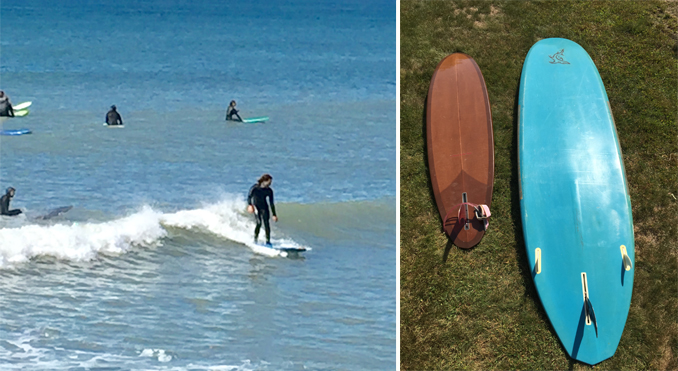
October 2020
To Leash, or not to Leash
Asking a surfer for their option on whether or not to wear a leash is likely to unleash a strong response.
Beginner surfers cannot imagine a session in the water without it, and expert surfers scoff at the idea of using one. Many surfers take a strong stance that Stand-Up Paddle surfers in the line-up should always wear one, even on small days. This lead us to explore why there is so much emotion tied to the idea of using a leash.
Big Surf: Strong swells with sizable waves are unfortunately rare out east, as are monster waves that would endanger a surfer’s life. The benefit of being tied to your board on a big day is lost if your board is dragging you into violent white water or underwater into the washing machine. How quickly surfers can release themselves from a leash while in this situation can mean life or death, especially if there is a strong current, rocks that catch the leash or being held down underwater. The leash can also snap in big surf, and not guaranteed to do so in the moments you would like it to break. The leash is meant to keep your board near by so you don’t have to swim and retrieve it, and to keep your board form flying into other surfers. It was not intended to save your life. If you are looking to your leash to do that, it’s best not to paddle out in the first place.
Legal “Leg-ropes”: Our Aussie friends shared with us the movement to make surfing illegal in certain spots if a surfer does not wear a “leg-rope.” Local surfers here feel like it shouldn’t be such a burden.
“Leash technology has improved so you can nose ride without issue. If you need to go leash-less, go in a secret spot or when people are not around you,” stated one local in the line-up.
Some argue leashes keep you safe if you take a beating in the water; once it stops you have the safety of your board near by. A creative pro-leash argument for wearing is one is that you end up surfing more and chasing your board less. You can also duck dive in an emergency when you absolutely have to ditch your board, at least you know its close by when you resurface.
Freedom from the ‘Ball and Chain’: Older surfers seem to enjoy surfing leash-less, feeling greater freedom even if they have to chase their board on wipeouts. For some it’s a right of passage, and others are just annoyed when the leash gets caught between their toes, or around their ankle. Particularly annoying is when the leash gets caught on a rock around the Point and east of Ditch. (Keeping the leash perpetually tied around your board, especially in seasons that you do not surf, makes the leash more likely to curl up in these places when you are in the water). There is a theory that surfers are more cautious when they surf without their leash, less likely to throw their board and to pay closer attention to what is around them. And just like a surfer’s own style, many feel that surfing without a leash just looks better. Is that enough of a reason not to wear one? Aesthetics?
Cutting the Cord: The irony of having a leash tied to your board is that it makes you more separated from your surfing, according to one of our fellow surfers.
“It makes surfers lazy when they wipe out, they pull the board to them rather than swim for it, they feel more carte blanche to wipe out, kick their board, let go in certain situations, and let the leash connection determine where they go,” says one Ditch local.
In some situations an angry surfer will throw their board knowing just a tug will easily retrieve it. If you surfed in the 70’s when leashes became popular, you would remember the annoyance that it made surfing too accessible to those that are inexperienced. This seems to be a common complaint in surfing regardless of the decade or the circumstance. Kicking a board out also means it comes back, in a way it could hurt you if it lands on your face or your body with force.
Ties to Safety: Novice and beginner surfers feel vulnerable without a leash, and if they are not able to keep their board close it might be better to have one. Does it give a false sense of security or allow surfers to go in over-their-head, or is it simply a preference?
One surfer commented, “With or without a leash, you have to maintain awareness of what is going on around you. You should be trying to hold on to your board no matter what, and swim after it even if you have a leash.” Others encourage practice: “Just like you fall flat whether or not you are over reef, when you are over reef you have the muscle memory to do it and you are less likely to get hurt,” says a surfer from Hawaii.
Maybe it is an individual choice. Some surfers feel safer when they see surfers without a leash.
“I know that if someone is confident to go leash-less, they must know what they are doing,” says one of the summer surfers at Ditch.
Most surfers agree that those on Stand-Up boards MUST wear one.
“No matter how well you surf, its too much of a weapon if a Stand-Up goes barreling through the surf without a leash, it is like getting pummeled by a kayak at a speed that will kill you,” says another local.
Ultimately it is up to you and the freedom of choice: to leash or not to leash?

